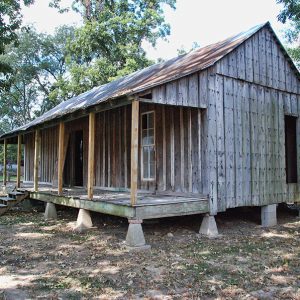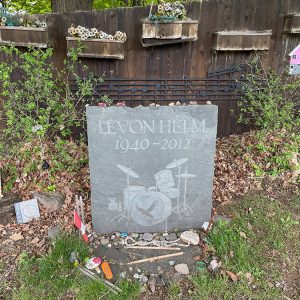calsfoundation@cals.org
Levon Helm (1940–2012)
aka: Mark Lavon Helm
Mark Lavon (Levon) Helm was best known as the drummer and singer for the Canadian rock group the Band. Following the demise of the Band, he continued to have a successful music career leading his own band, as well as acting in numerous motion pictures.
Levon Helm was born on May 26, 1940, outside Elaine (Phillips County) to Nell and Diamond Helm. He had two sisters and one brother. He grew up in Marvell (Phillips County) working on the family cotton farm but was always encouraged to play and sing music at home and in church. Helm knew that he wanted to become a musician at age six, after seeing bluegrass musician Bill Monroe perform. He began playing guitar at age eight but was inspired shortly afterward to become a drummer after seeing a performance by F. S. Walcott Rabbit’s Foot Minstrels, who had a left-handed drummer. He was also inspired by James “Peck” Curtis, the drummer for blues legend Sonny Boy Williamson, who frequently played in the area. Helm began spending time at the KFFA radio studio in Helena (Phillips County) listening to blues performers, and he watched live musical performances in Marvell. When he was twelve, he played guitar on the local music circuit accompanied by his sister Linda on washtub bass, performing at 4-H clubs and other civic-club gatherings. While in high school, he formed his first band, the Jungle Bush Beaters.
When he was seventeen, Helm got his first big break when he met Ronnie Hawkins, the rockabilly star born in Huntsville (Madison County), at the West Helena Delta Supper Club, where Hawkins was working sans drummer. The piano player knew Helm and suggested to Hawkins that the young drummer sit in with the band. Helm was asked to join the band, and once he graduated from high school in Marvell, he joined Hawkins’s band, the Hawks, on the road.
Levon went with Hawkins to Toronto, Canada, where the rockabilly sound was popular. In 1959, Hawkins signed to Roulette Records, and the Hawks recorded two hit albums in 1959, Forty Days and Mary Lou. Along with Helm, Hawkins gradually put together a stellar version of the Hawks that, by 1961, included future Band members—pianist Richard Manuel, bassist Rick Danko, guitarist Robbie Robertson, and keyboard and saxophone player Garth Hudson, all Canadians.
Wishing to expand their musical horizons, the band eventually broke away from Hawkins and began performing as Levon and the Hawks, playing rhythm and blues, blues, and rock and roll. Helm was given top billing, not only because of his seniority in the band but also because he was a member of the musicians’ union, while the others were not. In 1964, they released their first single, “Leave Me Alone,” on which they were listed as the Canadian Squires. They released two more singles that year as Levon and the Hawks: “The Stones I Throw” and “Go Go Liza Jane.”
Their reputation grew to the point that Bob Dylan asked them to be his backup band after he decided to amplify and incorporate more rock into his traditional folk music sound. The band accompanied Dylan on his 1966 tour of the United Kingdom, where they encountered some hostility to his new “electrified” sound. The hostility bothered Helm, so he went back home to Arkansas.
After Dylan’s near-fatal motorcycle wreck in July 1966, Dylan and the backup band moved to a pink split-level house, affectionately named Big Pink, in Woodstock, New York, in 1967. There they rehearsed and recorded music that would be released in 1975 as The Basement Tapes. Helm reunited with the group later that year to perform on some of the songs on The Basement Tapes.
In the spring of 1968, the Band—the name they and Dylan used to refer to the combo—recorded the music that would become Music from Big Pink, a widely acclaimed debut album. Released on Capitol Records in 1968, the album combined country and western, Appalachian, R&B, gospel, Cajun, and old-fashioned rock sounds—a synthesis of American music that greatly contrasted with the psychedelic rock more common to the period. In The Rolling Stone Album Guide, Paul Evans wrote that the album was “the group’s tour de force debut: Robertson’s ‘The Weight’ and the Dylan/Manuel ‘I Shall Be Released’ encapsulated the Band’s strengths—the lean grace of Robertson’s guitar, the understated drive of Levon Helm’s drumming, and especially the solo and ensemble brilliance of the group’s three singers.” Helm is credited on the album with mandolin and guitar in addition to vocals and drums.
Music from Big Pink peaked at No. 30 on the Billboard album charts, but the album had a huge impact on such rock luminaries as Eric Clapton, George Harrison, Pete Townshend, and Mick Jagger.
In 1969, the Band released its eponymous album, The Band, which included songs such as “The Night They Drove Old Dixie Down,” “Up on Cripple Creek,” “Across the Great Divide,” “Look Out Cleveland,” and “King Harvest (Has Surely Come).” In The Rolling Stone Album Guide, Evans called it “one of the richest and deepest records in rock history.”
The album The Band broke into the Billboard Top 10 on the album charts in late 1969, and the single “Up on Cripple Creek” broke into the Top 30 in late 1969. Meanwhile, in England, the Band’s fame grew as “The Weight” from their debut album reached No. 21 on the British charts. “Rag Mama Rag,” a single from the second album, was a Top 20 hit in the U.K. in April 1970.
Meanwhile, Helm was living with Libby Titus in Woodstock, and on December 3, 1970, their daughter, Amy, was born.
The Band’s popularity continued to grow, and they continued to tour and record albums, including Stage Fright (1970), Cahoots (1971), a live double album called Rock of Ages (1972), and Moondog Matinee (1973). In 1974, they reunited with Dylan to record the studio album Planet Waves. They also toured with him, releasing a live album, Before the Flood, which featured both Dylan and Band songs. In 1975, the double album The Basement Tapes, recorded with Bob Dylan in 1967, was finally released on Columbia Records. Subsequently, the Band released the albums Northern Lights/Southern Crosses (1975) and Islands (1977).
In 1976, Robbie Robertson announced that he was tired of the road and wanted the band to go out with one last hurrah. On Thanksgiving 1976, the Band performed their farewell concert, titled “The Last Waltz.” The concert, featuring such friends of the Band as Eric Clapton, Dr. John, Muddy Waters, Neil Young, Van Morrison, Ronnie Hawkins, and Joni Mitchell, was recorded for a triple album released in 1978. A documentary film of the event, directed by Martin Scorsese, was also produced and released that year as The Last Waltz.
Following the break-up of the Band, Helm signed to ABC records and released Levon Helm and the RCO All-Stars in 1977. The album featured Steve Cropper, Duck Dunn, Booker T. Jones, Dr. John, Paul Butterfield, and Fred Carter Jr. Helm followed up with the album Levon Helm in 1978. In 1980, Helm released the critically acclaimed album American Son on MCA. In 1982, he released an album called Levon Helm on Capitol Records.
Meanwhile, Helm had embarked on an acting career. He played Loretta Lynn’s father, Ted Webb, in Coal Miner’s Daughter in 1980, as well as Captain Jack Ridley in The Right Stuff (1983). He also appeared in End of the Line (1988), which was filmed primarily in Little Rock (Pulaski County), Staying Together (1989), and The Adventures of Sebastian Cole (1998). In 2005, he was in the Tommy Lee Jones–directed Three Burials of Melquiades Estrada. He also played the ghost of Confederate general John Bell Hood in the film In the Electric Mist starring Tommy Lee Jones and John Goodman.
In 1981, Levon married Sandra Dodd.
The Band, without Robbie Robertson, who chose not to join the re-formed Band, got together in 1983 and toured regularly. Richard Manuel committed suicide in 1986, but the Band carried on, recording three albums in the 1990s: Jericho (1993), High on the Hog (1996), and Jubilation (1998).
In 1993, Helm, with rock writer Stephen Davis, published a book about the Band’s rise to fame, This Wheel’s on Fire. In 1994, Helm was inducted along with the other members of the Band into the Rock and Roll Hall of Fame.
In the late 1990s, Helm survived throat cancer, which forced him to quit singing. Nonetheless, he formed a band, Levon Helm and the Barn Burners, with a group of Woodstock-area musicians. He also released his greatest-hits album, titled The Tie That Binds: The Best of Levon Helm, 1975–1996. At his home studio in Woodstock, he recorded an album titled Souvenir in 1997 with a Woodstock band called Crowmatix. He regularly performed with the Barn Burners, often with his daughter Amy on vocals.
In 2005, Levon began singing again, and in 2007, he released a new album, Dirt Farmer, on Vanguard, which garnered a Grammy in the Traditional Folk Album category. A second solo album, Electric Dirt, was released June 30, 2009, and went on to win a Grammy Award for Best Americana album.
In Woodstock, he performed monthly Midnight Ramble shows at his home; a 2011 performance with Mavis Staples was released posthumously in May 2022 as an album titled, Mavis Staples & Levon Helm: Carry Me Home. He also toured seasonally with the Levon Helm Band and occasional guest performers.
Helm died on April 19, 2012, from throat cancer. He is buried in Woodstock Cemetery in Woodstock.
In April 2013, a documentary about Helm titled Ain’t in It for My Health was released in Manhattan. Set in Helm’s New York home and directed by Jacob Hatley, it features him discussing his music career and his home state. That same year, New York State Route 375, which runs between Woodstock and West Hurley, was designated the Levon Helm Memorial Boulevard. Act 810 of 2017 designated U.S. Highway 49 from Marvell to Helena the Levon Helm Memorial Highway. In 2018, his boyhood home, which had been moved to Marvell from its original location in nearby Turkey Scratch (Phillips County), was listed on the Arkansas Register of Historic Places.
For additional information:
Ain’t in It for My Health: A Film about Levon Helm. https://www.youtube.com/watch?v=bMCurMyP4n8 (accessed July 11, 2023).
Barry, John W. Levon Helm: Rock, Roll, Ramble—The Inside Story of the Man, the Music, and the Midnight Ramble. N.p.: Barry Books, 2022.
Bowden, Bill. “Exhibit to Honor Arkansas Native Son Levon Helm.” Arkansas Democrat-Gazette, April 28, 2025, pp. 1B, 3B. Online at https://www.arkansasonline.com/news/2025/apr/27/the-bands-levon-helm-exhibit-slated-for-boston/ (accessed April 28, 2025).
Harvey, Paul. Southern Religion in the World: Three Stories. Athens: University of Georgia Press, 2019.
Helm, Levon. “The Music.” Razor Magazine (February 2004).
Helm, Levon, and Stephen Davis. This Wheel’s on Fire: Levon Helm and the Story of the Band. Chicago: Chicago Review Press, 2000.
Hill, Jack W. “Arkansan, Rocker, Rambler Helm Dies at 71.” Arkansas Democrat-Gazette, April 20, 2012, p. 2A.
Hoskyns, Barney. Across the Great Divide. New York: Hyperion, 1993.
“Levon Helm Boyhood Home.” Arkansas Historic Preservation Program. Arkansas Register of Historic Places.
Levon Helm Studios. http://www.levonhelm.com/ (accessed July 11, 2023).
Pareles, Jon. “Levon Helm, Drummer in the Band, Dies at 71.” New York Times, April 19, 2012. http://www.nytimes.com/2012/04/20/arts/music/levon-helm-drummer-and-singer
-dies-at-71.html?pagewanted=1 (accessed July 11, 2023).
Robertson, Robbie. Testimony. New York: Three Rivers Press, 2016.
Russell, Danny Aaron. “‘It Sounds Like We All Got Religion, Don’t it’: How Levon Helm and The Band Brought the Music of the Arkansas Delta to the World.” Arkansas Review: A Journal of Delta Studies 53 (April 2022): 3–15.
Scott, A. O. “Playing Notes That Linger.” New York Times, April 19, 2013, p. C10. Online at http://movies.nytimes.com/2013/04/19/movies/aint-in-it-for-my-health-directed-by
-jacob-hatley.html?_r=0 (accessed July 11, 2023).
Sellars, Jeff, and Kevin C. Neece, eds. Rags and Bones: An Exploration of The Band. Jackson: University Press of Mississippi, 2022.
Tooze, Sandra B. Levon: From Down in the Delta to the Birth of The Band and Beyond. New York: Diverson Books, 2020.
Bryan Rogers
North Little Rock, Arkansas
 Levon Helm Home
Levon Helm Home  Levon Helm
Levon Helm  Levon Helm
Levon Helm 




I came across an interesting discussion of the song “The Weight” here: http://theband.hiof.no/articles/the_weight_viney.html
It seems that the lyrics were deeply rooted in Fayetteville and other Arkansas locales:
“Levon Helm maintains that everyone in the song was known to them.
Levon Helm:
The song was full of our favorite characters. “Luke” was Jimmy Ray Paulman (of The Hawks). “Young Anna Lee” was Anna Lee Williams from Turkey Scratch. “Crazy Chester” was a guy we all knew from Fayetteville who came into town on Saturdays wearing a full set of cap guns on his hips–he was like Hopalong Cassidy and a friend of The Hawk’s.”
This was confirmed by a website post from Arkansas:
Sheila from Fayetteville:
My father in law told me about Crazy Chester. Chester used to walk everywhere. He wore a cheap red dime-store cowboy hat and wore his britches legs tucked into his cowboy boots. He knew everyone, and everyone knew him. It amazes me that I’ve been singing along with the lyrics of these songs for a long time and I’m just now learning that some of these people were right in my own backyard! The Band frequented the Iris Hotel, Tastee Freeze and the Rockwood Club here in Fayetteville. My mom in law was a waitress at the Rockwood and has met them all! Crazy Chester is from here too! Everyone here knows about him. WOW!
To paraphrase Dylan, “It’s all in the music.”
RIP, Levon; he was the real deal.
[Editor’s note: Posted originally on the Arkansas History Listserv in the days following Helm’s death; re-posted here with permission.]
Levon’s 1993 memoir This Wheel’s on Fire belongs on the reading list of any class on Arkansas history. The chapters that cover his growing up in the Delta during the 1940s and 1950s are riveting and a highlight of the book, even in light of all the great events he participated in and helped shape later.
When I hear a song like “The Weight” (take a load off Fanny…), I think he’s not concerned about hitting all the right notes or sounding pretty; what counts is the raw emotion that comes across, even if (especially if?) the singer is poor and uneducated. I think people identify with a voice like that over, say, the Mormon Tabernacle Choir. It’s that part of the American experience that is rooted in the backwoods and rural places and unyielding landscapes.
[Editor’s note: Posted originally on the Arkansas History Listserv in the days following Helm’s death; re-posted here with permission.]
Growing up in New Hampshire, I grew up listening to the Band and always thought Levon’s voice was one of the most American I’d ever heard. Not sure what I even meant by that, but when I heard him sing I heard American history. As luck would have it, years later I moved to Arkansas and only then did I even realize he was from there. I’ll never drive by Shadde’s Barbeque on Hwy. 49 and not think of him, as I was told that they catered his wedding.
A great loss to us all.
[Editor’s note: Posted originally on the Arkansas History Listserv in the days following Helm’s death; re-posted here with permission.]
Years ago, one of my Arkansas History students drew Levon Helm’s name from a pile for a presentation in class. He contacted Helm by email at his home in Woodstock, NY. My student was thrilled beyond words that he responded to the email and answered a series of questions the student had posed. To the question, “Why do you think so much remarkable and memorable music has been born in the Delta?” Helm’s short response was, “I think it’s in the dirt.” I thought you all would like to know how kind he was to respond to my student and to respond in such a profound way. [Editor’s note: Posted originally on the Arkansas History Listserv in the days following Helm’s death; re-posted here with permission.]